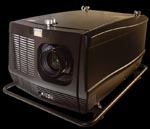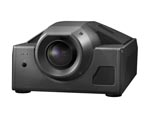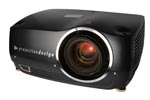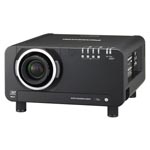- Okay, I'll admit it. I'm a terrible language student. Back in high school, it took me more years than I care to remember to finally pass the dreaded New York State Regents test for third-year French. My other dalliances in assorted foreign languages have been equally unsuccessful, though I can muddle through it when traveling or other obligations require. However, most importantly for everyday life in the 21st century, I've never been able to fully assimilate to that strange language known as "Starbuckian," where, instead of ordering a "small, medium, or large" it is "tall, grande, or venti." I'm always the victim of pity from those in line when I simply ask for a small. I guess that's the price you pay for a $5 cup of java.
- In considering the topic of large-venue projectors, my attempts at learning to speak Starbuckian come to mind. When considering what makes a venue truly large, it is often a matter of your context and the jobs you are used to. If you typically provision classrooms or boardrooms, a large auditorium is "large." On the other hand, if 250-seat lecture halls are your stock in trade, "large" means a big auditorium. Most would consider a theater installation "large," but these days some of the multiplex rooms being outfitted for digital cinema are probably smaller than some of the venti home theater installations featured in the design magazines. On the other hand, there is probably no doubt that mega-church installations, sports arena scoreboards, and artist magnification systems for road shows are clearly "large" venues.
- The physical size of the room aside, how do you know when to look for what the industry generally categorizes as a large venue? If the screen is more than 15 feet wide, if the throw distance is long, if the expectation for both a large screen and a high ambient light output is in the system requirements, and if you throw a requirement for high resolution in with all of the above, you're probably talking large venue. If you deal with these systems on a regular basis, consider yourself able to order your caffeinated drink without prompting from this video barista. However, if you merely dabble in them on an occasional basis, this month's column is meant to help you know what to order when you're tempted to get a large.
- Since many will associate large screens with cinema applications, it is easy to think that digital cinema projection systems are an easy bet for large-screen jobs. True, they do offer 2K or even 4K resolution, up to or over 20K ANSI lumen output, and the ability to throw images on screens up to 100 feet by 55 feet, but bigger isn't always better. Cinema projectors are typically intended for fixed installations, and the high light output comes with requirements for high-current AC power and careful planning for cooling and ventilation. Put simply, these aren't something you pick up at the local rental house, throw in the back of the truck, and throw up in the grid for a short-run event. They do have the ability to accept a wide variety of lenses, but that is no longer uncommon down through the range of more conventional large-venue products. They also tend to have comprehensive remote control and automation possibilities, but how much of that does your installation really need?
- Yes, they are the top of the line, and sometimes a dedicated digital cinema projector may be what you need, but more often than not, a non-cinema system is a better fit to the job. Indeed, though certain models from Christie Digital, NEC, and Barco, among others, are specifically designed for digital cinema, other models from Digital Projection, Sony, Panasonic, JVC, as well as the aforementioned digital cinema brands among others, do sometimes see digital cinema use, they are more suited to general purpose applications.
- These are the everyday large venue systems in that they are single cabinet, rather than dual-unit configuration, and while not exactly lightweight, they can be lifted by two to four workers using the side handles that are often part of the design. Where cinema projectors can be bolted to the floor, these units are adaptable to, and often seen in, a wide variety of mounting situations. Of course, as with anything that you fly or rig, always make certain that the both the product and the gear is designed, rated and approved for the application. Remember, these are "venti," and you don't want to be responsible for having one of these cups of projection coffee spill.
- Along with the ability to mount a large-venue projector in a wide variety of locations, take a look at the available lens options and light output adjustments. The good news is that you will find a wide range of possibilities-considerably more than the fixed lens and light output you are used to if you deal only with small-venue or conventional fixed installation projectors. With those riches, however, comes the potential for bad news if you don't read the spec sheets and price lists carefully. Optional lenses give you anything from anamorphic capabilities to very short, or very long, throw capability. Nice, but remember that the optional lenses aren't cheap and can bust your budget if you don't pay attention. Along with the lenses, check your requirements to see if any masking is needed to accommodate cinema playback requirements.
- Another thing to keep in mind for the venti venue novice is that the high light output that lets these projectors do their thing is no accident. In addition to the light engine design, they are centered around specialized bulbs, or in some cases bulb (or lamp, if you will) systems that use more than one bulb. Again, nothing wrong with that, but particularly when you are dealing with exotically named items such as "short arc 3KW lamps," the replacement isn't going to be something you (or your clients) can quickly get next to the "road warrior" class portable projectors at the local office supply store. When putting your bid proposal or RFQ response together when a large-venue projector is included, you're doing the client a major favor to include at least one spare. This not only means that it is available and on-hand when needed, but when the cost is higher, the first one or two replacements are accommodated in the initial capital expenditure or financing. After all, you don't want the church to realize they have to pass the collection plate just to keep their projection systems running.
- As you step up to the counter to order, you do need to know how to speak the language. At the lower end of the large venue market segment you will see resolution figures for both the units' native rate and those it accepts quoted in a manner similar to smaller portable and fixed installation models. If you speak SXGA, UXGA, WXGA, 1366 x 768 or better, you'll feel right at home. However, be prepared for some new ways to order. Taking their clue from imaging engines first developed for digital cinema, some large projectors are 2K, which is generally 2048 x 1080, or 4K, which is 4096 x 2160. You might not need this for an outdoor concert, but if the "large venue" is a command/control center or a medical training facility where color and resolution are mission critical, this is something you'll need to know about.
- In the twilight zone between physical and electronic are the types of signal connections to a large venue projector. Most have all the standard video inputs you need, but here, too, a careful look is required before specing a system. If playback from consumer-based high definition sources is required, do not assume that the HDMI connectivity you need is there. More at home with SDI digital sources in some cases, you may find a DVI connection, but HDMI may still be rare. If available, it may require the use of an optional plug-in card, also to be figured into the proposal. When it comes to DVI, another assumption not to be made is that you will be able to use adaptors or DVI-to-HDMI cables and be in good shape. Remember that while HDMI always includes the HDCP copy protection scheme, DVI can, but does not always. Some large-venue systems have it, some don't. If it is needed, check before presuming it is there.
- In the end, you must consider what ultimately matters most to the client-the bottom line. Our friends in the "enterprise" world of business computer systems correctly talk about TCO, or total cost of ownership. Not just what it costs to buy and install, but the cost to own and run the system over its lifespan. Anyone used to simply factoring in a new lamp every now and again should adjust their thinking when selecting a large-venue system so that you can present the client with an informed view of the initial and "over time" costs. Different brands with different projection engine technologies can have widely differing TCO figures to deliver the same image size and light output. If the TCO is high, is there some other feature of the system that you can point to in defending your recommendation? On the other hand, if the brand selected is not one the client had either requested or expected, will you include the backup documentation to show why TCO factors led to a specific unit selection? These projectors are not toys, and they are certainly not inexpensive. Never forget that the comfort factor you telegraph in presenting in a system integration bid in going to the bottom line from more than just a "here's what it costs" standpoint will serve you well in a world where bean counters are as important as the end-users.
- Bean counters! An interesting way to wrap up the commentary when coffee is the hook for our trip into the world of large venue projectors. With "tall" and "grande" projectors more common than "venti," it is never a bad idea to play off the things mentioned here and brush up on your ability to speak large venue before venturing into the world of venti. The good news is that if you play your cards right, it isn't just the projectors that will be large, your order book and profits will grow in size as well.
New Projectors 2007
NEC's NP4000
Designed primarily for corporate, government, and higher education facilities that require a powerfully projected image, NEC's 5000 ANSI lumen, XGA-native NP4000 features a full line of optional lenses with power horizontal and vertical lens shift for flexible placement anywhere. The NP4000's single or dual lamp operation allows users the flexibility to choose a light output that is right for the application. The NP4000 incorporates advanced video processing with BrilliantColor and DynamicBlack from Texas Instruments to deliver picture management control. Additionally, the NP4000 features user-changeable color wheels with four segments for full brightness or optional six segments for superior color fidelity.

Barco's FLM HD18
Barco's FLM HD18 is a quiet 18,000 lumens native HD projector, that is designed for applications in large events and venues. It also solves the increased need to project high brightness native HD images. The FLM boasts fully sealed optics and lamp maintenance ensuring an overall lower cost of ownership. Moreover, the lens range (TLD HB) of the Barco RLM and SLM projector series can be re-used on the FLM series, meaning users do not have to invest in new lenses.

Sony's SRX-S105 And SRX-S110
Sony's SRX-S105 (5,000 lumens) and SRX-S110 (10,000 lumens) each are equipped with three silicon X-tal reflective display (SXRD) imaging devices, delivering a resolution of 4096 x 2160 pixels (H x V)--more than four times the resolution of full HDTV (1920 x 1080). Both the SRX-S110 and the SRX-S105 offer a high contrast ratio of >1800:1 for precision imagery. Each projector is equipped with a DVI signal input module as standard, which provides the 1080/60P input capability available only with these units. In addition to the standard DVI input, three slots are available for the installation of other input modules.

Projectiondesign's F30 Projector
A new professional projector from projectiondesign, the powerful F30 sx, displays pictures from single-chip DLP with DarkChip3 technology. This projector features Texas Instruments BrilliantColor technology that enhances images by reproducing a wider color spectrum and dramatically increases color saturation and visible gamut. The professional F30 sx+ series also features the unique projectiondesign RealColor technology, to deliver outstanding calibration and perfect color reproduction. The F30 has been designed to perform in a variety of environments and specialized applications such as simulators, 2D and 3D visualization and entertainment venues, as well as medical imaging, post-production, control rooms and display signage.

Panasonic's PT-DW10000U
Panasonic's new DLP system projector with 10,000 lumens of brightness is the PT-DW10000U, a full high-definition projector that can faithfully display HD content. High brightness is assured by a four-lamp system that delivers 10,000 lumens, while dynamic iris technology achieves a 5,000:1 contrast ratio. Three-chip DLP technology provides excellent resistance to deterioration due to aging, making the PT-DW10000U a reliable system projector.
Eiki's LC-XT4U
The LC-XT4U is Eiki's brightest projector yet. 12,000 ANSI lumens deliver a contrast of 1300:1. The optical imaging engine is optimized for extended use. The LC-XT4U uses native XGA and is compatible with UXGA through VGA, capable of video scaling. It can project images up to 40 feet wide (600 inches diagonal). It contains a quick-change lens installation system. A wide choice of lens is also available. It is compatible with most video signal inputs, including DVI, RGB, Y/C, DVD, and HDTV. It displays video 4:3 and 16:9 in NTSC/PAL/SECAM/NTSC 4.43/PAL-M/PAL-N. Th DVI input supports HDCP for true digital imaging.
